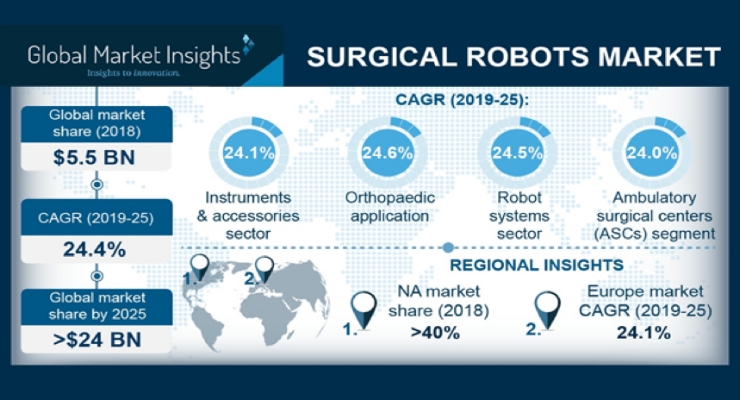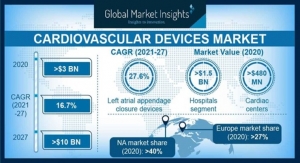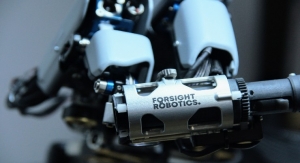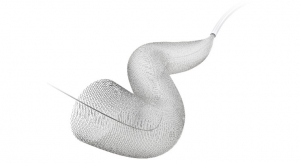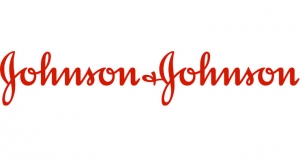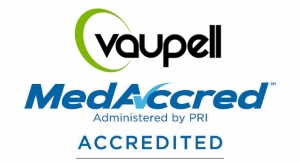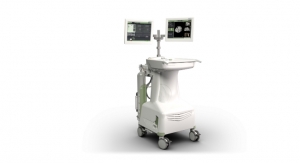Global Market Insights04.04.19
The Surgical Robots Market is set to grow from its current market value of more than $5.5 billion to over $24 billion by 2025; as reported in the latest study by Global Market Insights Inc.
A large patient pool suffering from chronic diseases in developed as well as developing countries will drive the demand for robotics in surgical procedures. An increase in the number of surgeries owing to the rising prevalence of chronic diseases will spur surgical robots’ business revenue. Growing patient preference towards minimally invasive procedures to prevent post-operative trauma and complications will foster surgical robots’ market growth during the forecast period.
Growing demand for minimally invasive surgeries will lead to the development of technologically advanced surgical robots, fostering business growth in the foreseeable future. For instance, Intuitive Surgical has developed da Vinci single-site technology that provides multiport, single-incision surgical procedures, enhancing its acceptability among physicians and patients. High accuracy level and increased reliability offered by surgical robots owing to technological advancements will positively impact industry growth.
The robotic systems segment held significant revenue share in 2018 and is anticipated to witness over 24.5 percent CAGR by 2025. Segment growth is attributable to technological advancements in robotics resulting in wide applicability in various surgical procedures. The focus of industry players on frequent upgrading of technology allows the introduction of innovative and advanced robotics capable of performing more complex surgical procedures with minimal efforts and high precision. Such factors should accelerate segment growth over the forthcoming years.
The gynecology application segment accounted for more than 17 percent of revenue share in 2018 and will show similar growth in the foreseeable future. Segment growth is attributed to the introduction of robotic assistance in the field of gynecological surgeries such as hysterectomy, abdominal myomectomy, tubal reanastomoses, radical hysterectomy, lymph node dissections, and sacrocolpopexies. Growing patient preference toward a robotic approach to overcome shortcomings of conventional suture-intensive gynecological surgeries will increase adoption of robotically-assisted minimally invasive procedures, thereby accelerating segment growth.
The ambulatory surgical centers (ASCs) segment was valued more than $1.5 billion in 2018, owing to increasing patient preference towards ambulatory surgical centers that offer minimally invasive procedures. Various robot-assisted procedures such as cardiac, urology, gynecology, as well as other general surgeries performed in these centers at affordable prices, will favor segment growth during the forthcoming years.

U.S. surgical robots market size, by component, 2018 & 2025 (USD million).
The North American surgical robots market witnessed over 40 percent revenue share in 2018 and is anticipated to grow substantially over the analysis timeframe. Increasing healthcare expenditure in the region, coupled with increasing demand for technologically advanced surgical procedures, will drive North American surgical robots industry growth. Strong foothold of key industry players in the region focusing on technology upgrades will favor business growth.
Eminent industry players operational in the surgical robots market include Accuray, Globus Medical, Hansen Medical, Intuitive Surgical, Johnson & Johnson, Mazor Robotics, Omni, Stryker, Think Surgical, and Zimmer Biomet. These industry players adopt strategies such as geographic expansion, partnerships, mergers, and novel product launches to sustain market competition.
A large patient pool suffering from chronic diseases in developed as well as developing countries will drive the demand for robotics in surgical procedures. An increase in the number of surgeries owing to the rising prevalence of chronic diseases will spur surgical robots’ business revenue. Growing patient preference towards minimally invasive procedures to prevent post-operative trauma and complications will foster surgical robots’ market growth during the forecast period.
Growing demand for minimally invasive surgeries will lead to the development of technologically advanced surgical robots, fostering business growth in the foreseeable future. For instance, Intuitive Surgical has developed da Vinci single-site technology that provides multiport, single-incision surgical procedures, enhancing its acceptability among physicians and patients. High accuracy level and increased reliability offered by surgical robots owing to technological advancements will positively impact industry growth.
The robotic systems segment held significant revenue share in 2018 and is anticipated to witness over 24.5 percent CAGR by 2025. Segment growth is attributable to technological advancements in robotics resulting in wide applicability in various surgical procedures. The focus of industry players on frequent upgrading of technology allows the introduction of innovative and advanced robotics capable of performing more complex surgical procedures with minimal efforts and high precision. Such factors should accelerate segment growth over the forthcoming years.
The gynecology application segment accounted for more than 17 percent of revenue share in 2018 and will show similar growth in the foreseeable future. Segment growth is attributed to the introduction of robotic assistance in the field of gynecological surgeries such as hysterectomy, abdominal myomectomy, tubal reanastomoses, radical hysterectomy, lymph node dissections, and sacrocolpopexies. Growing patient preference toward a robotic approach to overcome shortcomings of conventional suture-intensive gynecological surgeries will increase adoption of robotically-assisted minimally invasive procedures, thereby accelerating segment growth.
The ambulatory surgical centers (ASCs) segment was valued more than $1.5 billion in 2018, owing to increasing patient preference towards ambulatory surgical centers that offer minimally invasive procedures. Various robot-assisted procedures such as cardiac, urology, gynecology, as well as other general surgeries performed in these centers at affordable prices, will favor segment growth during the forthcoming years.

U.S. surgical robots market size, by component, 2018 & 2025 (USD million).
The North American surgical robots market witnessed over 40 percent revenue share in 2018 and is anticipated to grow substantially over the analysis timeframe. Increasing healthcare expenditure in the region, coupled with increasing demand for technologically advanced surgical procedures, will drive North American surgical robots industry growth. Strong foothold of key industry players in the region focusing on technology upgrades will favor business growth.
Eminent industry players operational in the surgical robots market include Accuray, Globus Medical, Hansen Medical, Intuitive Surgical, Johnson & Johnson, Mazor Robotics, Omni, Stryker, Think Surgical, and Zimmer Biomet. These industry players adopt strategies such as geographic expansion, partnerships, mergers, and novel product launches to sustain market competition.

